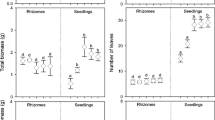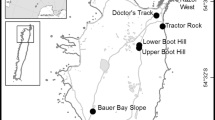Abstract
When weeds can reproduce both sexually and vegetatively, limits on weed density and population growth can vary with the relative success of different reproductive modes. Such considerations are particularly important for sustained management with biological control (biocontrol), which relies on selectively targeting demographic processes that limit weed populations. We conducted a survey of 100 Euphorbia virgata Waldst. & Kit. (leafy spurge) populations across three U.S. states to quantify weed genetic diversity, density, and associated root-feeding biocontrol agent (Aphthona species complex) abundance. Aphthona spp. reduce survivorship and clonal recruitment, and their impacts may indirectly influence the value of seed-based recruitment to weed population increase and persistence. We intended to provide insight into: 1) the frequency of seedling recruitment among populations, which is strongly related to population genetic diversity in clonal plants such as E. virgata; and 2) the degree to which E. virgata density is related to the abundance of Aphthona spp. agents and inferred clonality within local weed populations. We found high genetic diversity across all sites, suggesting frequent recruitment from seed. Aphthona complex biocontrol agents were ubiquitous, but associations between agent abundance and E. virgata density were variable. Sites with the lowest E. virgata density had low Aphthona abundance, but otherwise agent abundance was not strongly associated with plant density. Increased population-level importance of seed production may be changing the priority of demographic targets for biocontrol, e.g., elevating the importance of seed-reducing agents, after decades of Aphthona pressure on clonal reproduction in E. virgata invasions. Further empirical evaluation is needed to ensure management tools, such as biocontrol, are sufficient for long-term sustainable control.


Similar content being viewed by others
Data availability
All data are available from the National Agricultural Library Ag Data Commons website at: https://doi.org/10.15482/USDA.ADC/1528351.
References
Anderson JM, Willden SA, Dallin L et al (2015) Long term outcomes of population suppression of leafy spurge by insects in the mountain foothills of northern Utah. Am Midland Naturalist 174:1–13
Berry PE, Riina R, Peirson JA, et al. (2021) Euphorbia. In: Flora of North America North of Mexico. Flora of North America editorial committee, New York and Oxford, http://beta.floranorthamerica.org/Euphorbia
Dice L (1945) Measures of the amount of ecologic association between species. Ecology 26:297–302
Gaskin JF (2006) Clonal structure of invasive hoary cress (Lepidium draba) infestations. Weed Sci 54:428–434
Gaskin JF, Endriss SB, Fettig CE et al (2021) One genotype dominates a facultatively outcrossing plant invasion. Biol Invasions 23:1901–1914
Gaskin JF, Littlefield JL (2017) Invasive Russian knapweed (Acroptilon repens) creates large patches almost entirely by rhizomic growth. Invasive Plant Sci Manag 10:119–124
Gaskin JF, Littlefield JL, Rand TA et al (2022) Variation in reproductive mode across the latitudinal range of invasive Russian knapweed. AoB Plants 14:plac032
Gassmann A, Schroeder D (1995) The search for effective biological control agents in Europe: history and lessons from leafy spurge (Euphorbia esula L.) and cypress spurge (Euphorbia cyparissias L.). Biol Control 5:466–477
Harper JL (1977) Population biology of plants. Academic Press, London
Joshi A, Olson DL (2009) Revisiting leafy spurge biocontrol: a case study. Rangelands 31:31–35
Lym RG (1998) The biology and integrated management of leafy spurge (Euphorbia esula) on North Dakota Rangeland. Weed Technol 12:367–373
Progar RA, Markin G, Milan J et al (2011) Population dynamics and impacts of the red-headed leafy spurge stem borer on leafy spurge (Euphorbia esula). Invasive Plant Sci Manag 7:183–188
Ramula S, Knight TM, Burns JH et al (2008) General guidelines for invasive plant management based on comparative demography of invasive and native plant populations. J Appl Ecol 45:1124–1133
Rolf FJ (1992) NTSYS-PC: numerical taxonomy and multivariate analysis system. Exeter Software, Setauket
Schaffner U, Hill M, Dudley T et al (2020) Post-release monitoring in classical biological control of weeds: assessing impact and testing pre-release hypotheses. Curr Opinions Insect Sci 38:99–106
Selbo SM, Carmichael JS (2000) Reproductive biology of leafy spurge (Euphorbia esula L.): breeding system analysis. Can J Bot 77:1684–1688
Watkinson AR, Powell JC (1993) Seedling recruitment and the maintenance of clonal diversity in plant populations–a computer simulation of Ranunculus repens. J Ecol 81:707–717
Yokomizo H, Takada T, Fukaya K et al (2017) The influence of time since introduction on the population growth of introduced species and the consequences for management. Popul Ecol 59:89–97
Acknowledgements
The authors thank M. Maggio and the Montana Biological Control Project, T. Breitenfeld and the Whitehall Biocontrol Program, D. Srygley and C. Steenrod (ARS) and K. Ragotzkie (BLM) for field collections, and C. Steenrod, J. Morkin, K. Mann, and J. Lassey for insect and genetic sample processing.
Funding
Provided by the USDA Forest Service BCIP program and the US-DOI Bureau of Land Management.
Author information
Authors and Affiliations
Corresponding author
Ethics declarations
Conflicts of interest
The authors have no conflicts of interest to declare.
Additional information
Publisher's Note
Springer Nature remains neutral with regard to jurisdictional claims in published maps and institutional affiliations.
Supplementary Information
Below is the link to the electronic supplementary material.
Rights and permissions
About this article
Cite this article
West, N.M., Gaskin, J.F., Milan, J. et al. High genetic diversity in the landscape suggests frequent seedling recruitment by Euphorbia virgata Waldst. & Kit. (leafy spurge) in the northern U.S.A. Biol Invasions 25, 645–652 (2023). https://doi.org/10.1007/s10530-022-02954-9
Received:
Accepted:
Published:
Issue Date:
DOI: https://doi.org/10.1007/s10530-022-02954-9




